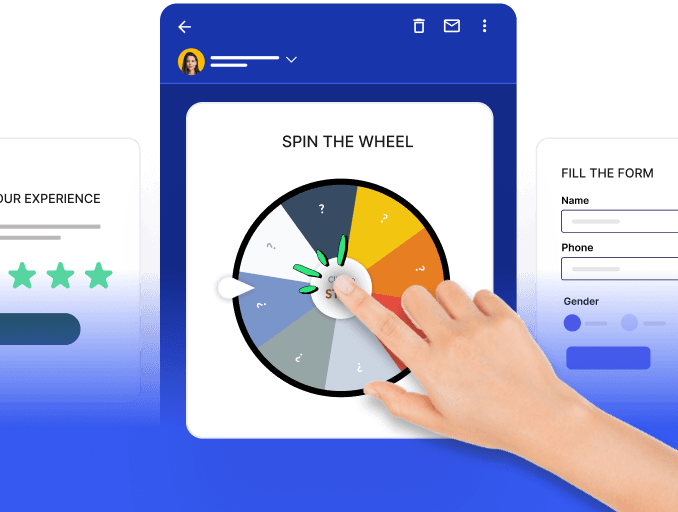Email has become an essential communication channel for individuals and businesses alike. But have you ever stopped to think about the different parts of an email? Understanding the anatomy of an email can help you focus on each part and make it more effective. This, in turn, will help you craft more effective and engaging emails. In this article, we will break down an parts of an email and delve into each part of an email to understand it better.
Table of contents
- 1. Sender/from
- 2. The subject line
- 3. The pre-header
- 4. The salutation
- 5. The email body
- 6. Closing line
- 7. Signature
- 8. Call to Action (CTA)
- 9. Attachments
- Takeaways
1. Sender/from
The first part of an email that catches your attention is the sender's information. The "From" field displays the sender's email address or name. To build trust and prevent accidental deletions, the sender's name must match the company's identity. For instance, if your company is called Mailmodo, use a name that reflects this, such as "Mailmodo" or "Mailmodo Team."
You can also try using a familiar name, as they are more likely to open and engage with the email if they see a familiar sender.
2. The subject line
The most critical part of an email is the subject line. It acts as a headline for your email, determining whether recipients will open it. Here are some things to keep in mind when crafting a subject line for your email:
It should be accurate, informative, and enticing.
Avoid spammy or misleading taglines.
It should pique the reader's curiosity while remaining truthful.
Write winning subject lines with our free ebook
Proven subject line framework to get higher opens
3. The pre-header
Accompanying the subject line is the pre-header, which appears as the initial line of text below the subject line in certain email providers, such as Gmail or on mobile devices. The pre-header provides additional information besides the subject line and acts as a teaser to entice readers to open the email.
It is an excellent opportunity to expand on the subject line and give recipients a glimpse of what they can expect from the email content. Use this space wisely to communicate the purpose of the email effectively and encourage recipients to open it.
4. The salutation
The salutation sets the tone of your email and establishes a connection with the recipient right from the start. It is essential to strike a balance between being professional and friendly. If you have the recipient's name, personalized greetings like "Hi John" or "Dear Sarah" can create a more personal touch.
However, if you don't have their name, opt for a friendly yet professional greeting. Avoid generic salutations like "To whom it may concern," as they can appear impersonal and detached.
5. The email body
The email body is the most important part of your email, where you convey your message and provide value to the recipient. If your email body doesn’t align with your subject line, you email is more likely to get reported as spam. Here are some things you should keep in mind while writing an email body:
It should be concise.
Make your email body conversational.
Use images, videos and other visual elements to make it more appealing.
Use interactive elements to make your email more engaging.
Deliver relevant and valuable content.
6. Closing line
Like a traditional letter, it's polite to include a closing at the end of your email. The closing should match the tone and purpose of your email. The closing helps to create a sense of closure and leaves a positive impression on the recipient.
For formal or professional emails, consider using closings like "Sincerely" or "Thank you." In more casual or friendly emails, you can opt for closings like "Talk to you soon!" or "See you later!"
7. Signature
In many business emails, it is customary to include a signature block at the end. The signature typically includes the sender's name, job title, contact information, and sometimes the company logo.
This information helps recipients identify the sender and provides credibility to the email. Consider creating a professional and concise signature that aligns with your brand's image.
8. Call to Action (CTA)
A call to action (CTA), if defined, is an instruction to the reader that encourages them to take immediate action. It can be a button, link, or phrase that prompts the reader to do something, such as sign up for a newsletter, download a file, or make a purchase.
The ultimate goal of your email is to prompt the recipient to take action. Here are some things you should keep in mind while designing your CTA:
Makes it clear and easy for the reader to understand what the CTA does.
Use action-oriented language and create a sense of urgency to motivate readers to take immediate action.
Incorporate clickable buttons or hyperlinks to guide them to the desired action.
9. Attachments
Attachments can be a valuable addition to your emails, allowing you to share additional information or files with your recipients. Whether it's a document, image, or any other file type, attachments can enhance the functionality of the email and provide more context to your message.
Takeaways
To sum up, there are several important elements to consider when crafting an effective email. An attention-grabbing subject line, engaging content, a strong call to action, attachments, etc. An understanding of all the key components will help you craft them better and result in a perfect email.
💡 Related guide: Email Format: Tips, Best Practices, and 7 Examples to Follow
FAQs
An email typically consists of three fundamental parts: the header, the body, and the signature. The header includes the sender's and recipient's email addresses, subject line, and date. The body contains the main message, while the signature often includes the sender's contact information.
The email body is where the actual message is written. It can be a simple text message or include various elements like images, links, and attachments. The body is where you convey the information or communicate your message to the recipient.
The subject line is essential because it provides a brief but informative summary of the email's content. A well-crafted subject line can capture the recipient's attention and give them a clear idea of what the email is about, which can increase the likelihood of it being opened and read.
An email signature typically includes the sender's name, job title, company name, contact information (phone number and address), and often a link to the sender's professional social media profiles. It serves as a polite and professional way to provide additional contact details and context to the recipient.
What should you do next?
Thanks for reading till the end. Here are 3 ways we can help you grow your business:

Get smarter with our email resources
Explore our email marketing guides, ebooks and other resources to master email marketing.

Do better email marketing with Mailmodo
Send app-like interactive emails with forms, carts, calendars, games, etc. to boost email ROI.

Talk to an email expert
Get a 30-min. free email consultation with a Mailmodo expert to optimize your email marketing.




